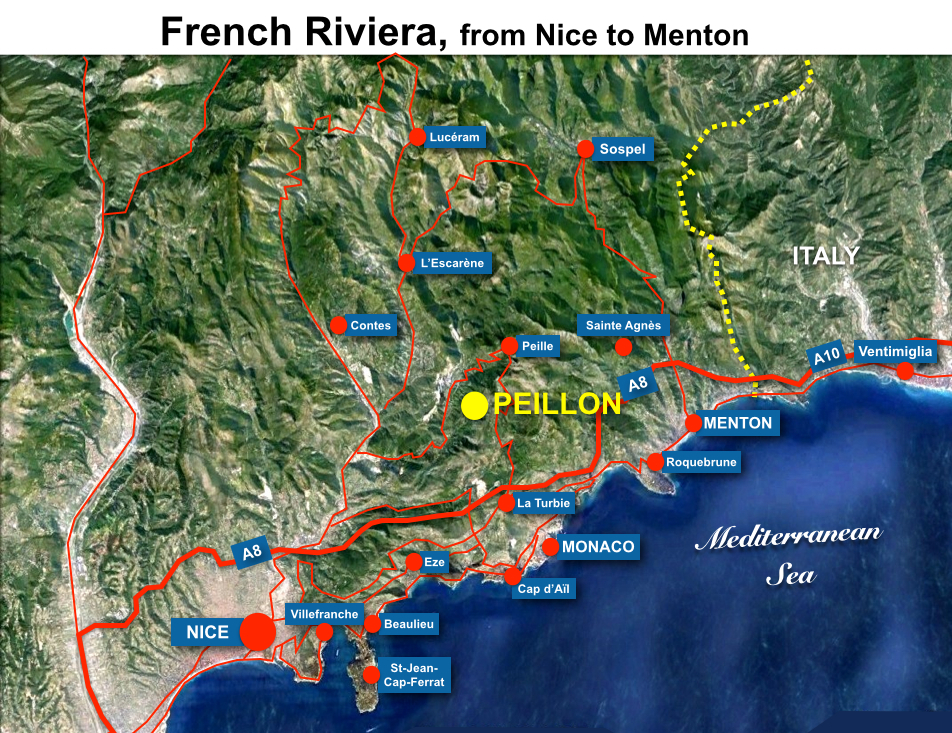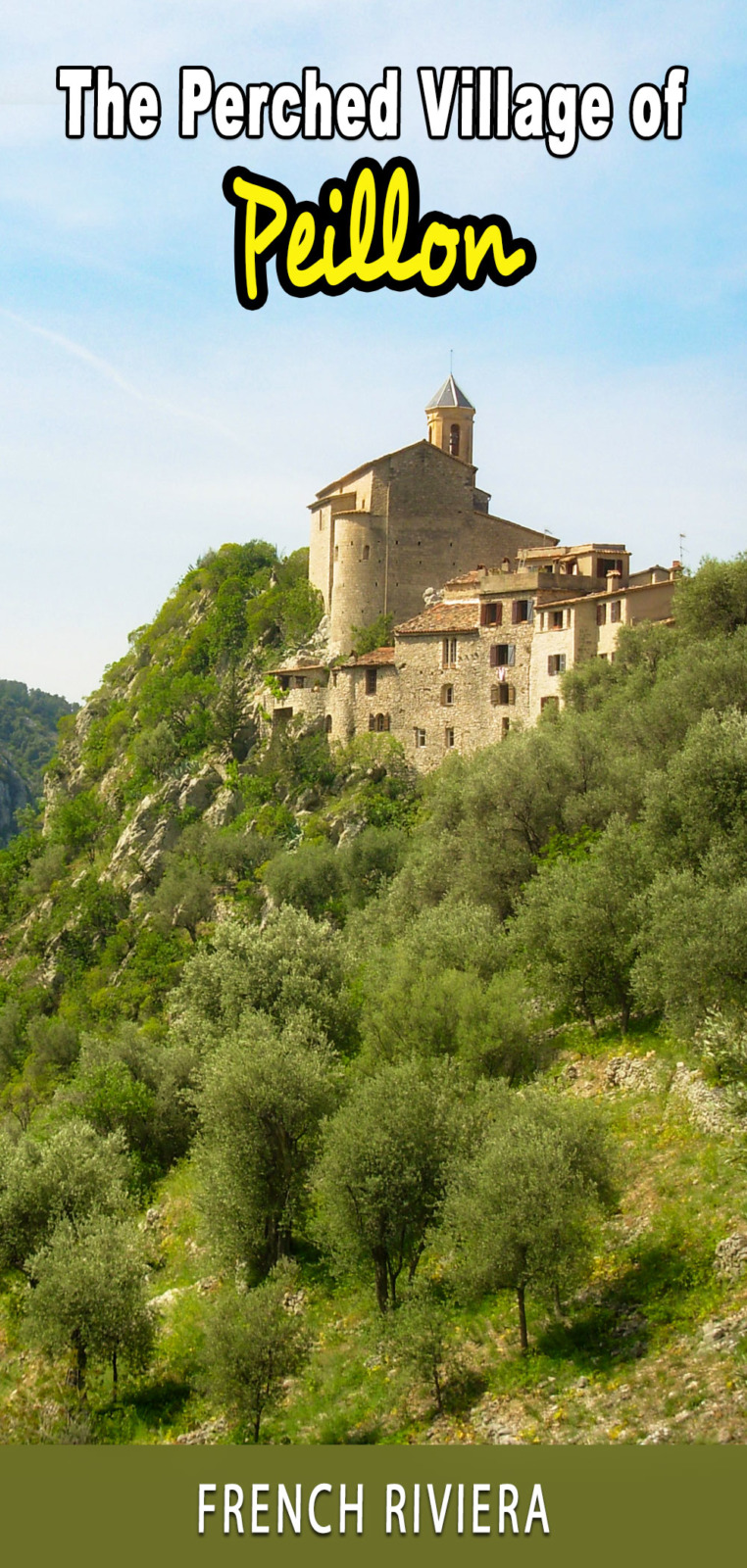Situated in the hinterland of Nice, picturesque Peillon is one of the most beautiful villages of the French Riviera. You’ll discover this beautiful village on an eagle’s nest on a sheer cliff. A visit to the old village offers an unforgettable journey through history. The old town invites you to stroll through its winding streets cut by vaulted passages and wide staircases. Whilst its tall old houses and its doors with their patina of age are enchanting.
Plan your trip to Peillon and the region of Nice!
- 🏨 Find the best accommodations in Nice and the region on Booking.com
- 🙋♀️ Get the PASS CÔTE D’AZUR and take your pick from more than 100 amazing experiences!
- 🌴 Read our Discovery Guides of Eze, Menton, Monaco, Peille and La Turbie.
- 🎯 Take a guided hidden gem tour of Monaco
- 🥗 Experience the culture and food of Old Nice on a 4-hour sightseeing and tasting tour
- 📚 Read the DK Eyewitness Provence and the Côte d’Azur Travel Guide
- 🤩 Get familiar with the French Riviera
- 🚗 Park your car at the entrance to the village (D121 road)
Situation of Peillon
Peillon lies only 20 km north of Nice in the Prealps of Nice. The commune is crossed by the D21 road that links Nice to L’Escarène and Peille.
Peillon is a commune comprising of 6 hamlets:
- Borghéas,
- Châteauvieux,
- le Moulin,
- les Novaines,
- Sainte-Thècle,
- and the old hilltop village.
In the valley of the Paillon de l’Escarène, Sainte-Thècle serves as the chief-town. This is where you’ll find the town-hall, the post office and the railway station.

From Sainte-Thècle (altitude 181 m), the “Route du Vieux Village” (Old Village Road) with its hairpins leads up to the entrance to the old village at 372 m where you’ll find a few parking spaces.
Peillon: a bit of history
![Peillon - General view of the old Village © Mossot - licence [CC BY-SA 3.0] from Wikimedia Commons](https://frenchmoments.eu/wp-content/uploads/2014/08/Peillon-Old-Village-03-©-Mossot-licence-CC-BY-SA-3.0-from-Wikimedia-Commons-1.jpg)
The first mention of Peillon dates to 1150 under the name “Guauceranus de Pellom“.
The name of the village has the same root that gave its name to the neighbouring village of Peille. Thus, the name of the village would have its origin in:
- the Lower-Latin word “pel” which is a variant of the Latin word “bal” designating a rock or a height.
- the Provençal suffix “on” or “oun” or the Occitan diminutive “lon” or “loun“
Until the village became part of France in 1860, the official name was Peglione in Italian.
The hilltop village in the Middle-Ages
Peillon is one of the many villages in the hinterland of Nice that are built on rocky peaks. This enabled the inhabitants to protect themselves from invasions and looting in the Middle Ages. To reinforce their security, the villagers built their houses tightly together to form a rampart and surround the castle that dominated them.
Until 1235, Peillon belonged to the territory of the neighbouring village of Peille.
In 1388, Peillon came under the authority of the House of Savoy. The village became French during the French Revolution and the Napoleonic Era.
From 1814 to 1860, Peillon and the County of Nice belonged to the Kingdom of Piedmont-Sardinia.
After the referendum of 1860, the whole region joined France.
Peillon: The Old Village
The village, which has retained its authenticity, occupies a rocky spur over a steep ravine. It is only with a little distance that one can see how tightly packed the settlement is.
![Peillon - General view of the old Village © Mossot - licence [CC BY-SA 3.0] from Wikimedia Commons](https://frenchmoments.eu/wp-content/uploads/2014/08/Peillon-Old-Village-©-Mossot-licence-CC-BY-SA-3.0-from-Wikimedia-Commons-1.jpg)
The village itself is pedestrian and as you can imagine, it was not designed for cars Therefore you can explore Peillon on foot, wandering up and down the narrow little streets whose houses seem to cling to the rock.
The visit to the hilltop village
The narrow streets, with their staircases and vaulted bridges, contain several treasures of heritage. These treasures have earned the village of Peillon the title of one of the most beautiful perched villages in France:
- The wash houses and the fountain in the lower square (19th century), listed as a historical monument
- The baroque church of the Transfiguration
- the chapel of the White Penitents and its 15th-century frescos.
Place Arnulf and the fountain
The visit to Peillon begins with Place Arnulf. The fountain dates from 1800 and draws water from several springs.
![Peillon - The fountain dating from 1800 © MOSSOT - licence [CC BY-SA 3.0] from Wikimedia Commons](https://frenchmoments.eu/wp-content/uploads/2014/08/Peillon-Fontaine-©-MOSSOT-licence-CC-BY-SA-3.0-from-Wikimedia-Commons.jpg)
On the square, hundred-year-old plane trees offer generous shade in summer.
Inside the village, the winding streets are mostly made up of stairways with arcades spanning them. They lead up to the top of the village where the church stands.
![The street of Peillon with stairs and vaulted passages © Mossot - licence [CC BY-SA 3.0] from Wikimedia Commons](https://frenchmoments.eu/wp-content/uploads/2014/08/Peillon-Street-03-licence-CC-BY-SA-3.0-from-Wikimedia-Commons-1.jpg)
![Peillon - An old street in the village © Mossot - licence [CC BY-SA 3.0] from Wikimedia Commons](https://frenchmoments.eu/wp-content/uploads/2014/08/Peillon-Street-02-©-Mossot-licence-CC-BY-SA-3.0-from-Wikimedia-Commons-1.jpg)
![An old street of Peillon © Mossot - licence [CC BY-SA 3.0] from Wikimedia Commons](https://frenchmoments.eu/wp-content/uploads/2014/08/Peillon-Street-04-©-Mossot-licence-CC-BY-SA-3.0-from-Wikimedia-Commons-1-scaled.jpg)
![Peillon - Under the arch of a narrow street © Mossot - licence [CC BY-SA 3.0] from Wikimedia Commons](https://frenchmoments.eu/wp-content/uploads/2014/08/Peillon-Street-01-©-Mossot-licence-CC-BY-SA-3.0-from-Wikimedia-Commons-1.jpg)
The village church
At the top of the village, you will find the parish church of Saint-Sauveur (or church of the Transfiguration).
![Peillon - Église de la Transfiguration © Mossot - licence [CC BY-SA 3.0] from Wikimedia Commons](https://frenchmoments.eu/wp-content/uploads/2014/08/Peillon-Église-de-la-Transfiguration-©-Mossot-licence-CC-BY-SA-3.0-from-Wikimedia-Commons.jpg)
It is exactly here that a fortified castle once stood. In the 12th century, the square keep became the bell tower of the new chapel in Romanesque style.
In 1643, the present baroque church replaced the old chapel.
The neo-classical façade with its triangular pediment dates from 1772. The bell tower with a high octagonal lantern dominates the chapel.
The interior reflects the influence of the rustic baroque with its twisted columns in faux marble and trompe l’oeil windows.
![Peillon - The choir of the parish church © Mossot - licence [CC BY-SA 3.0] from Wikimedia Commons](https://frenchmoments.eu/wp-content/uploads/2014/08/Peillon-Eglise-de-la-Transfiguration-Maitre-Autel-©-MOSSOT-licence-CC-BY-SA-3.0-from-Wikimedia-Commons.jpg)
The church has two chapels with a painting of the “Madonna of the Rosary” (1639) on the left and the “Death of Joseph” (1722) on the right.
The little square in front of the sanctuary has benches and a great vista of the surroundings of Peillon made up of steep forested mountains and deep valleys.
The Chapel of the White Penitents
Below the village, the chapel of Notre-Dame des sept Douleurs or chapelle des Pénitents Blancs is a must-see.
![Chapelle des Pénitents Blancs © Mossot - licence [CC BY-SA 3.0] from Wikimedia Commons](https://frenchmoments.eu/wp-content/uploads/2014/08/Peillon-Chapelle-des-Pénitents-Blancs-Facade-©-MOSSOT-licence-CC-BY-SA-3.0-from-Wikimedia-Commons.jpg)
The sanctuary houses remarkable frescoes by Jean Canavesio dating from the 15th century (between 1485 and 1490).
![Chapelle des Pénitents Blancs © Mossot - licence [CC BY-SA 3.0] from Wikimedia Commons](https://frenchmoments.eu/wp-content/uploads/2014/08/Peillon-Chapelle-Pénitents-Blancs-©-Harrie-Gielen-licence-CC-BY-SA-4.0-from-Wikimedia-Commons.jpg)
![Chapelle des Pénitents Blancs © Mossot - licence [CC BY-SA 3.0] from Wikimedia Commons](https://frenchmoments.eu/wp-content/uploads/2014/08/Peillon-Chapelle-des-Pénitents-Blancs-©-Mossot-licence-CC-BY-SA-3.0-from-Wikimedia-Commons.jpg)
![Chapelle des Pénitents Blancs © Mossot - licence [CC BY-SA 3.0] from Wikimedia Commons](https://frenchmoments.eu/wp-content/uploads/2014/08/Peillon-Chapelle-Pénitents-Blancs-Fresques-©-Harrie-Gielen-licence-CC-BY-SA-4.0-from-Wikimedia-Commons.jpg)
To admire the frescoes, you must insert a coin in the coin box or follow a guided tour (contact the Tourist Office of Peillon for more details).
The chapel of Saint-Roch and the oratory of La Merla
Afterwards, continue your discovery of the surroundings of the village with a short walk to the chapel of Saint Roch or to the oratory of La Merla.
The chapel of Saint Roch dates from 1580 (restored in 2004). From the path leading to the oratory, you can enjoy a magnificent view of the village.
The oratories and calvaries of Peillon
The commune of Peillon has many oratories and calvaries.
Oratories are small chapels used for prayer. They house the statue of a saint.
They can be found on the outskirts of the village: the oratory of the Immaculate Conception, the oratory of the Madonette, the oratory of the Merla… For the villagers, the oratories have long served as reassuring and protective landmarks.
Finally, the many walking and hiking trails in the surrounding area allow you to discover the unique site of the hilltop village of Peillon.

Finally, unlike other attractive villages, Peillon is free of gift shops, cafés and restaurants which makes the visit to the authentic village much more agreeable.
The valley and Sainte-Thècle
In the green, wooded and cultivated valley, a unique network of irrigation canals runs through the whole commune. There you can still visit the old hydraulic oil and flour mills, which are remarkably well preserved.
Interestingly, the village still grows olive trees and produces olive oil.
In 1948, the hamlet of Sainte-Thècle in the valley became the seat of the village administration.
![The church of Sainte Thècle © Jpchevreau - licence [CC BY-SA 3.0] from Wikimedia Commons](https://frenchmoments.eu/wp-content/uploads/2014/08/Peillon-Eglise-de-Sainte-Thècle-©-Jpchevreau-licence-CC-BY-SA-3.0-from-Wikimedia-Commons.jpg)
The museum of railway heritage
In Sainte-Thècle, the museum of railway heritage “Flaminius Raiberti” occupies the old station, renovated in its original form of 1928.
The museum allows you to discover the spectacular Nice-Cuneo railway line. You will discover objects that were part of the railwayman’s luggage and documents from the period.
If you are an amateur, enthusiast, professional or simply curious, the museum is the best place to understand the life of the railways in the Maritime Alps.
The Sainte-Thècle Springs
The Sainte-Thècle springs played a historic role in the first drinking water supply for the city of Nice.
In 1860, the Sardinian administration was already interested in the Sainte-Thècle springs with a view to supplying the City of Nice, but this did not materialise.
In 1864, the City of Nice approved a project to tap these springs and build a 15-kilometre canal from Peillon to Nice.
Napoleon III gave his approval for the work, which was completed one year later, in 1868. Of the three catchments created on the mainsprings, only one is still in operation today. It has supplied the commune of Peillon since 1954.
![Sainte-Thècle - the parish church © Jpchevreau - licence [CC BY-SA 3.0] from Wikimedia Commons](https://frenchmoments.eu/wp-content/uploads/2014/08/Peillon-Eglise-de-Sainte-Thècle-©-Jpchevreau-licence-CC-BY-SA-3.0-from-Wikimedia-Commons-1.jpg)
English-French Vocabulary
(f) for féminin, (m) for masculin, (adj) for adjective and (v) for verbs
- castle = château (m)
- county = comté (m)
- French Riviera = Côte d’Azur (f)
- House of Savoy = Maison de Savoie (f)
- mountain = montagne (f)
- perched village = village perché (m)
- Prealps = Préalpes (f,p)
- village = village (m)
Pin it for later!

Featured image: licence [CC BY-SA 3.0] from Wikimedia Commons



